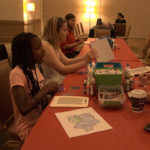There are any number of experiences and wake-up calls that can inspire an individual toward charity, and lead an organization toward establishing a CSR program. Three events — a brutal storm, a dozen tractor-trailers filled with conference waste, and an awareness of a crime taking place under the meetings industry’s radar — brought this year’s PCMA Community Advocate of the Year finalists to causes that fired their passion, and clinched their company’s commitment. Last month, they were celebrated at the PCMA Education Foundation’s Visionary Awards in Washington, D.C., and while Jeff Chase was named the winner that evening, they are all heroes in our book. Here are their stories.
Rachael Riggs, Manager Meeting and Convention Sales Midwest U.S., Tourism Vancouver

When Hurricane Harvey struck last year, Riggs saw a startling post on the PCMA Catalyst listserv from a meeting planner in Houston. A woman’s entire company had just been affected — 2,000 people displaced from their homes, as well as their corporate headquarters, by the storm and flooding damage.
“I responded to her, ‘Are you ok?’ And we kept up this email conversation, and I learned what they were going through,” Riggs said. “This was during the first 24 hours and they were in shock. They needed everything.”
Riggs and her colleagues at the PCMA Greater Midwest Chapter struggled to think of ways to help. They wanted to rush to Texas and help on the ground, but on such short notice, didn’t know where to go, what to do, or whether it was even safe to be there. Riggs heard that the Red Cross was doing an excellent job with food and water, but that residents found themselves without the most basic of belongings. So they came up with the idea of creating an Amazon wish list, and having the items sent to be distributed from the garage of a resident whose home hadn’t been affected.
“There were kids going to school with no shoes or socks, and just the one set of clothes on their back for five days. They needed everything,” she recalled. “It was a total grassroots effort and it was totally nimble, which I love. I was proud of our chapter being able to move so quickly. If you think about it, in the travel industry we have a really cool network of people who have the pulse of what’s going on in crisis situations, and the connections to be in touch and act fast. There’s a lot of potential for quick action there.”
Jeff Chase, Vice President of Sustainability, Freeman Company

Few things say “excess” like a tractor-trailer loads of waste leaving a convention. And few things give Jeff Chase greater satisfaction than seeing those trucks — filled with food, furniture, stationery, flooring, you name it — headed to local organizations that can put them to good use.
“Most shows send 40, 50 percent of their waste to landfills. But if you do the advance planning and proper thinking, you can donate a lot to the community, put things in the right recycling bin and do the right thing,” Chase said. His work with the monolithic CES (Consumer Electronics Show) in Las Vegas — where “the volume of waste is huge, the biggest waste show we have” — can be reined in to a more manageable 75 percent reclaimed materials. And with Greenbuild International, a show dedicated to sustainability in the construction industry, that figure soars to 90 percent.
Chase has been head of sustainability for Freeman since 2011, when the global events company bought Chase’s planning firm, including its portfolio of green-focused clients. In those seven years, Chase has seen the demand for green operations soar. “In the beginning, it was hard to identify really how many environmentally focused clients Freeman had,” he said. “Many people do want to do the right thing, but after putting so much effort into planning a show, don’t want to put the time into the end of the show — what will happen with all the things used. But a little time makes a huge impact.” Chase estimates that green-minded clients now represent $400 million of Freeman’s business.
Some of the things he’s helped repurpose: Tools, tile, hardwoods, carpeting, countertops, and flooring used in exhibits at a hardware show were diverted to industry interns and building organizations like Habitat for Humanity. Truckloads of unopened small packages of food from displays of a convenience store association convention were sent to multiple locations of Ronald McDonald houses. Playthings from a massive toy fair that needed to be unboxed and constructed for display — but don’t lend themselves to going back into boxes — hello, Toys for Tots. “Whatever your show is about, whether it’s medical or fancy food, you’ve brought all these things: tables and chairs for booths, carpeting and décor to make the booth special,” Chase said. “And in so many cases it’s just thrown away.”
Ken Sien, Director of Strategic Accounts, Experient, A Martiz Global Events Company

Maritz’s commitment to combatting human trafficking began with a lightning-bolt of a wake-up call for the company’s president four years ago. At an industry event, David Peckinpaugh found himself in a discussion about the unwitting role travel venues took in the sexual exploitation of children. Someone showed him an online ad, a photograph of a very young girl posed seductively in a hotel room. Plainly visible through the window was the outline of not some foreign skyline, but the arch in St. Louis — Peckinpaugh’s own hometown.
“His response was, ‘Oh my God this is in my own backyard,’” recalled Ken Sien, the most recent co-chair of the trafficking awareness committee. “People think children are abused this way in other countries, but the truth is, it’s in hotels everywhere. And David said, ‘We can’t just sit by and close our eyes to this in our industry.’”
When Sien volunteered to be co-chair of the company’s CSR program in 2016, he was motivated by concern that the committee’s focus was faltering. The mission had become diffuse: What were they really trying to accomplish? They weren’t likely to be able to ride in and rescue victims that law-enforcement had been unable to find. However, with so many industry members in hotels and airports and on the roads, they could make a difference in awareness, and add many sets of eyes watching the dark corners.
Sien and the committee’s training program focus on education, and the signs of children and teens traveling in the barely visible binds of these arrangements. “Typically the children will not make eye contact with you. They will not have identification, they have a solemn look, and they really don’t even know where they are,” he said. “If you try to say hello, the person … pimping them, for lack of a better word … will speak up for them, and usually look a little shady.”
Sien and his team have worked with local safe houses such as The Covering House, have created a card with an 800 number for reporting suspicious activity, have brought in speakers, and have acted as speakers themselves for other organizations looking to make trafficking their CSR. They are also working to encourage participation in the app TraffickCam, where travelers can upload photos of hotel rooms worldwide from many angles — increasing the database for law enforcement to find the visual clues to identify places where the commercial exploitation of minors is happening.
Above all, Sien wants to keep up the visibility of the problem, in hopes increasing the industry coalition of suppliers will sign on with The Code of Conduct, a travel and tourism initiative to fight human trafficking. “It’s not a flavor of the month for us,” Sien said. “It’s a commitment.”
Learn more about:
- Tourism Vancouver’s VanGiving initiative at tourismvancouver.com/meetings/why-vancouver/vangiving/.
- Freeman’s sustainability initiatives at freeman.com/about/sustainability.
- The travel and tourism industry’s initiative to fight human trafficking by signing The Code of Conduct at thecode.org/about.



